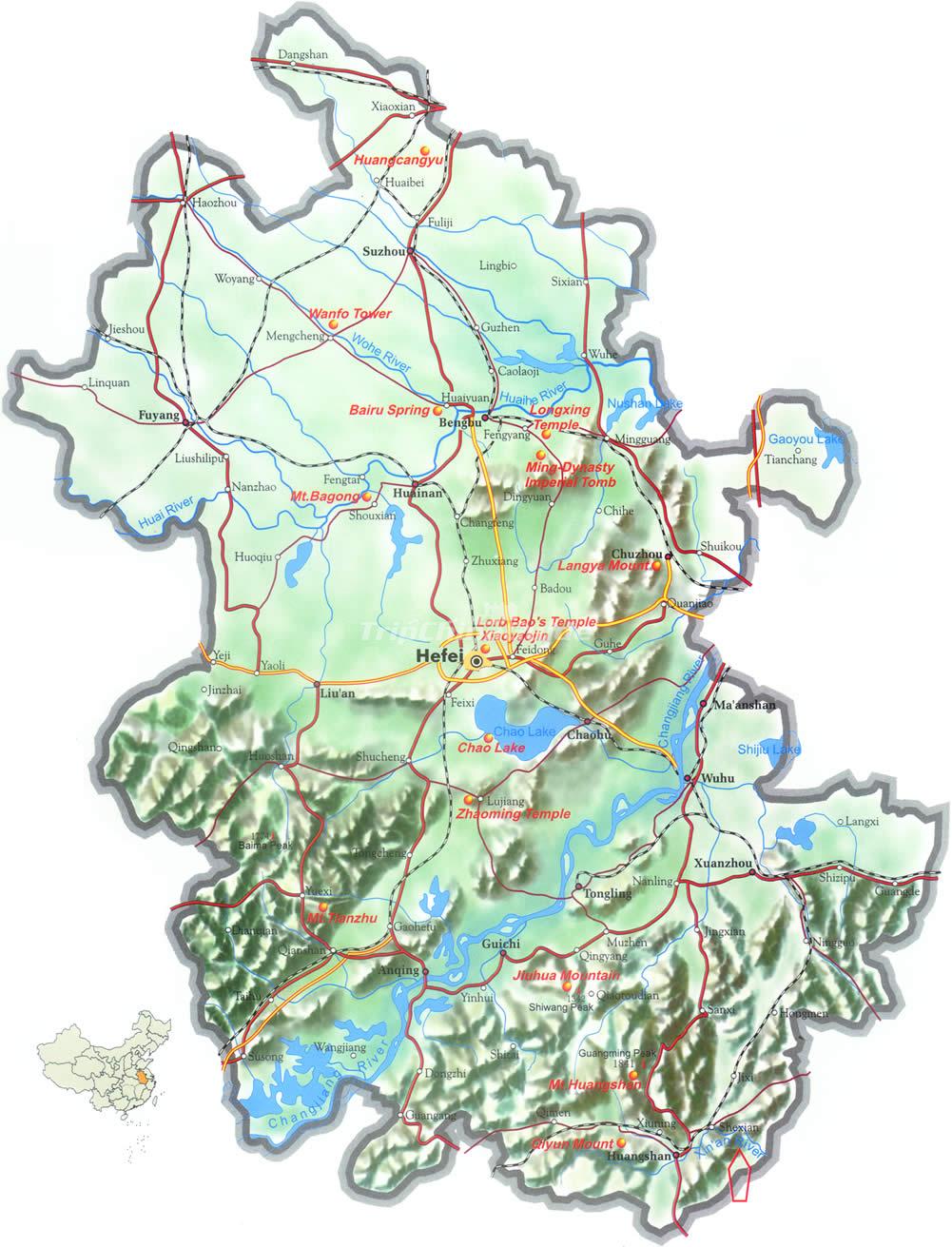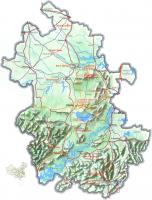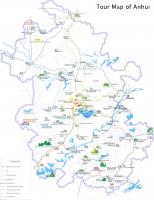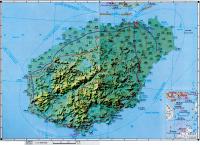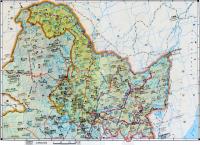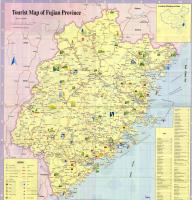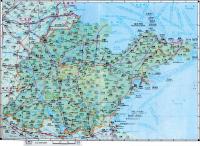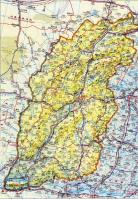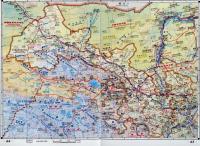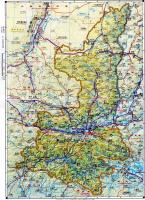Maps of Anhui
Location
Anhui Province in southeastern China is situated 29.25 to 34.39 degrees north latitude and 114.43 to 119.38 degrees east longitude. Lying in the middle and lower valleys of the Yangtze and Huai rivers, it borders Henan, Shandong, Jiangsu, Zhejiang, Jiangxi and Hubei provinces. It is an inland province in China.
Administrative divisions
As an inland province in China, Anhui is divided into 16 prefecture-level cities, with Hefei city as capital. The 16 prefecture-level cities are subdivided into 105 county-level divisions (44 districts, five county-level cities, and 56 counties). Those are in turn divided into 1845 township-level divisions (972 towns, 634 townships, nine ethnic townships, and 230 subdistricts).
City List of Anhui
Hefei, Anqing, Bengbu, Bozhou, Xuancheng, Chizhou, Chuzhou, Fuyang, Huaibei, Huainan, Huangshan, Lu'an, Ma'anshan, Suzhou, Tongling, Wuhu
Area
Anhui province is about 570 km from south to north and 450 km from east to west. It covers an area of 139.6 thousand square kilometers, about 1.45 percent of the total area of the country.
Topography
There are various landforms in Anhui. The Yangtze River and Huai River flow through the province and divide the whole province into three main natural area to the Huai River, the area between the Huai River and the Yangtze River and the south area to the Yangtze River. Some major mountains, such as Mount Dabie, Yellow Mountain, Mount Jiuhua and Tianzhu Mountain lie in Anhui, and the highest peak of Yellow Mountain---Lotus Peak is 1,860 meters above sea level. Among many rivers and lakes in Anhui, Chaohu Lake is one of the five great freshwater lakes in China, with an area of 800 square kilometers.
Population
It is with a population of 59,500,500 (2010).
Climate
The part of Anhui north of the Huaihe River has a warm-temperate, semi-humid monsoonal climate while the part south of the river has a sub-tropical, humid monsoonal climate. The mean annual temperature is above 14 to 16 degrees Celsius from north to south - the hottest month, July, averaging 27-28 degrees Celsius and the coldest month, January, -3-3 degrees Celsius - and the mean annual precipitation is 750-2,000 mm. The best season to visit Anhui is in autumn, around September and October with great weather condition like little rain, sunny day and comfortable temperature.
History
Anhui Province was set up in the sixth year of Kangxi Reign of Qing Dynasty (1667). "Anhui", the name of the province, comes from the combination of the first character of two prefectures' names at that time: Anqing and Huizhou. Because there was a mountain called “Wan Mountain” and an ancient nation named “Wan” in Spring and Autumn period in Anhui (722 BC–481 BC), “Anhui” is also called “Wan” for short.
Historical Evolution
Anhui is one of the most important cradles of China's pre-historical civilization. It has been discovered that even 2.5 million years ago, human beings already inhabited the site in the Inverted V Cave (the shape of the Chinese character of "man") in Fanchang County. The Hexian County's Sinanthropus Site of the Paleolithic Age (300,000 or 400,000 years ago) was excavated in the Dragon Pool Cave of Hexian County. These excavations have demonstrated that many generations of people have lived in this area since ancient times. During the Neolithic Age (between 4,000 and 10,000 years ago), Anhui belonged to the cultural domains of Yangshao, Longshan, Qingnianand Veined Chinaware.
The Xuejiagang Site, excavated in Qianshan County, has a long history of about 5,000 to 6,000 years. This ancient cultural site, revealing mostly Neolithic relics, is of great importance in the research of the primitive culture in the middle and lower reaches of the Yangtze River. Yu, the historical reputed founder of the Xia Dynasty, had a close relation with Anhui. According to the historical records, Yu met with local lords at Tushan and all the lords paid tributes to him.Tushan is the ancient Dangtu County in today's Horsehead Town, southeast of Huaiyuan County in Anhui. Bozhou was once the capital of the Chengtang State in the Shang Dynasty (1,600 - 1,100 B.C), while the ancient Shouchun (today's Shouxian County) was the capital of the late Chu State in the Warring States Period (475-221 B.C). The ancient copper tripod caldron excavated from the tombs of the Chu Dynasty is just little lighter than Simuwu Rectangle Ding, a bronze cooking vessel with two loop handles and four legs, of the Shang Dynasty. In the Qin Dynasty, according to the administrative division at that time, the area north to the Huai River belonged to Tang Prefecture and Sishui Prefecture, the area between the Huaihe River and the Yangtze River belonged to Jiujiang Prefecture, and the area south to the Yangtze River belonged to Zhang Prefecture. During the East Han and West Han dynasties, Anhui belonged to Yang, Yu, and Xu prefectures. In the period of the Three Kingdoms (A.D. 222-280), Anhui was dominated by the State of Wu andthe State of Wei, and was a battle field innumerable times. In the period of the Jin Dynasty, Southern and Northern dynasties and the Sui Dynasty, Anhui belonged respectively to Yang, Xu and Yu prefectures. In the SongDynasty, Hui merchants flourished quickly, economy and culture of Hui Prefecture created great influence on the whole nation.
In the Yuan Dynasty, Anhui was governed by Henan Province, Jiang and Zhe administrative provinces. In the Ming Dynasty, Anhui was under the direct administration of the Capital of Nanjing, and the province was subdividedinto seven prefectures and four counties: Anqing, Huizhou, Ningguo, Chizhou, Taiping, Luzhou and Fengyang prefectures, and Chu, He, Xu and Guangde counties. In the Qing Dynasty, Anhui was set up as a province with eight prefectures and five counties: Huizhou, Ningguo, Chizhou Taiping Anqing, Luyang, Fengyang, Yingzhou prefectures, and Guangde, Chu, He, Lu'an counties. At the beginning of the Republic of China (1912-1949), Anhui was divided into Wuhu, Anqing, and Huaisi prefectures. After the founding of the People's Republic of China, Anhui was divided into the two prefectures of Northern Anhui and Southern Anhui, with Hefei as the capital of Northern Anhui and Wuhu the capital of Southern Anhui. In1952, North Anhui and Southern Anhui were merged to form AnhuiProvince, and Hefei was selected as the provincial capital city.
Gushouchun (now called Shou County) was once the capital of the Chu kingdom in the Spring and Autumn period (BC770-476). Daze village in Suzhou witnessed the first peasant uprising in Chinese feudal history. The Feishui battle (AD383) also happened in Bagong Mountain in the Huainan region in the Eastern Tsin dynasty. Great poets during the Tang and Song dynasties, such as Libai, Dumu, Liu Yuxi and Ou Yangxiu, visited this region, leaving many unforgettable poems. Guo Zixing, Zhu Yuanzhang (later became the first emperor in Ming dynasty) revolted the Yuan dynasty in Haozhou (near Fengyang and Dingyuan city at present) and finally overthrown it by Ming Dynasty (AC1364). Before the 1911 revolution, Anhui witnessed heroic movements against government oppressors, such as the assassination of Anhui governor Enming by Xu Xilin and the Mapaoying uprising by Xiong Chengji. In January 1941, there saw the Wannan event (At that period, the two parties united together to fight against Japanese invaders but Kuomingtang assassinated many communists in Wannan, violating the coalition) in Jin county (the headquarters of the New Fourth Army of Communist).
Culture
Anhui spans many geographical and cultural regions. The northern, flatter parts of the province, along the river Huai He and further north, are most akin to neighbouring provinces like Henan and Shandong. In contrast, the southern, hilly parts of the province are more similar in culture and dialect to other southern, hilly provinces, like Zhejiang and Jiangxi.
Mandarin dialects are spoken over the northern and central parts of the province. Dialects to the north (e.g. Bengbu dialect) are classified as Zhongyuan Mandarin, together with dialects in provinces such as Henan and Shandong; dialects in the central parts (e.g. Hefei dialect) are classfied as Jianghuai Mandarin, together with dialects in the central parts of neighbouring Jiangsu province. Non-Mandarin dialects are spoken in the south: dialects of Wu are spoken in Xuancheng prefecture-level city, though these are rapidly being replaced by Jianghuai Mandarin; dialects of Gan are spoken in a few counties in the southwest bordering Jiangxi province; and the Huizhou dialects are spoken in about ten counties in the far south, a small but highly diverse and unique group of Chinese dialects.
Huangmei Opera, which originated in the environs of Anqing in southwestern Anhui, is a form of traditional Chinese opera popular across China. Huiju, a form of traditional opera originating in the Huizhou-speaking areas of southern Anhui, is one of the major precursors of Beijing Opera; in the 1950s Huiju (which had disappeared) was revived. Luju is a type of traditional opera found across central Anhui, from east to west.
Tourism
Anhui is famous not only for its picturesque mountains, rivers but also boast traditional cultures like Hui-style ancient villages. Below are some tourist places in Anhui that worth a visit:
*Yellow Mountain - it is renowned as the most beautiful mountain under heaven, boasts its towering pines, precipitous stones, wonderland cloud-sea and hot springs;
*Mount Qiyun-It is a mountain and national park located in Xiuning County. It lies some 33 kilometres to the west of Huangshan City and is known as one of the Four Sacred Mountains of Taoism. Noted for its numerous inscriptions and tablets, as well as monasteries and temples, the highest point of the mountain rises to 585 metres.
*Mount Jiuhua - one of the four Buddhist Shrines in China and boast as great summer resort
*Mount Tianzhu - The mountain locates in Qianshan County, Anqing City. Tianzhu Mountain has 45 peaks which are 1000 meters above sea level. Its highest point has an elevation of 1,760 metres . One of the famous sites of the mountain is the Mystery Valley. It is a maze-like valley formed by the rocks falling from the mountain. The valley has 53 caves, which form a very complicated maze.
*Xidi and Hongcun villages - where the famous Oscar winner Crouching Tiger, Hidden Dragon was filmed there, also listed as World Heritage Site with Mt.Huangshans.
*Tunxi Ancient Street - An old street paved with maroon flagstones originated in Song dynasty, around 800 years ago
*She County - reputed as Town of Arches, is also a must for each visitor who wants to experience fine examples of residential architecture from the Ming and Qing Dynasties and the unique Tangyue Memorial Archway.
Food
Anhui Cuisine is one of the most Eight Culinary Traditions in China. It comprises the specialties of South Anhui, Yanjiang and Huai Bei. The highly distinctive characteristic of Anhui cuisine lies not only in the elaborate choices of cooking materials but also in the strict control of cooking process.
Anhui is a inland province with plenty of natural resources, which provides much wild herbs for Hui-style cuisine, such as pangolin, stone frog, mushroom, bayberry, tealeaves, bamboo shoot, dates, games, etc., are from mountain area. Huangshan Mountain has abundant products for dish cooking.
Anhui Cuisine comprises the specialties of South Anhui, Yanjiang and Huai Bei. The highly distinctive characteristic of Anhui cuisine lies not only in the elaborate choices of cooking materials but also in the strict control of cooking process. The chefs pay more attention to the taste, color of dishes and the temperature to cook them, with braising and stewing the major cooking techniques. Generally the food here is slightly spicy and salty.
Most famous dishes include Stewed Soft Shell Turtle with Ham, Bamboo Shoots Cooked with Sausage and Dried Mushroom, and etc.
Anhui Specialty
The special local products include the Four Treasures of Study - Xuan paper, Chinese paintbrushes, Hui ink, Xi ink stone, as well as some world-renowned tea products, like Maofeng Tea and Keemun Black Tea.
Minerals
Anhui has 138 kinds of minerals that have been discovered to date, 111 of which have been explored and mined. Its reserves in 12 minerals rank among the top 10 in the nation, including coal, iron, copper, sulfur and limestone.
Economy
It is one of the important agricultural provinces, with products ranging from rice, wheat, cotton, vegetable oil crops, cotton, tea, jute, silkworm cocoons, and roast tobacco, etc. Its main mineral deposits are coal, iron ore, and copper ore. Anhui occupys great resources like land resources, biological resources, water resources and abundant natural resources like minerals; including coal, iron ore, and copper ore.
Transportation
*Roads
The province has 148,400 km of roads, including 2,206 km of expressways. The length of expressways will reach 3,500 km by 2010.
*Railroads
Anhui has the most railway mileage in east China. Both the Beijing-Shanghai and Beijing-Kowloon railroads run through the province
*Aviation
Hefei and Huangshan are the two aviation hubs in Anhui serving both domestic and foreign flights. Four other airports have direct flights to major domestic cities.
*Waterways
The province has three main rivers--the Yangtze, the Huaihe and the Xin'an. There are five open inland river ports including Ma'anshan, Wuhu, Tongling, Chizhou and Anqing along the 400-km Anhui section of the Yangtze.







